最新83-用insert语句插入记录-《sqlserver程序设计语言》
C#--SqlServer--插入一条数据和插入多条数据的方法
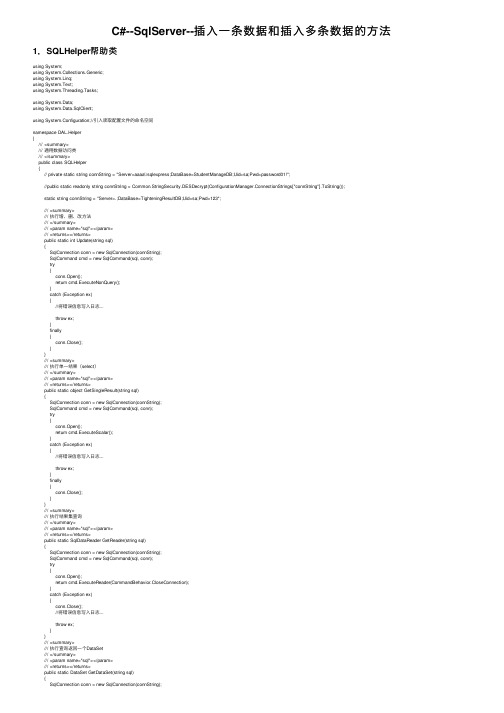
C#--SqlServer--插⼊⼀条数据和插⼊多条数据的⽅法1,SQLHelper帮助类using System;using System.Collections.Generic;using System.Linq;using System.Text;using System.Threading.Tasks;using System.Data;using System.Data.SqlClient;using System.Configuration;//引⼊读取配置⽂件的命名空间namespace DAL.Helper{/// <summary>/// 通⽤数据访问类/// </summary>public class SQLHelper{// private static string connString = "Server=aaaa\\sqlexpress;DataBase=StudentManageDB;Uid=sa;Pwd=password01!";//public static readonly string connString = Common.StringSecurity.DESDecrypt(ConfigurationManager.ConnectionStrings["connString"].ToString());static string connString = "Server=.;DataBase=TighteningResultDB;Uid=sa;Pwd=123";/// <summary>/// 执⾏增、删、改⽅法/// </summary>/// <param name="sql"></param>/// <returns></returns>public static int Update(string sql){SqlConnection conn = new SqlConnection(connString);SqlCommand cmd = new SqlCommand(sql, conn);try{conn.Open();return cmd.ExecuteNonQuery();}catch (Exception ex){//将错误信息写⼊⽇志...throw ex;}finally{conn.Close();}}/// <summary>/// 执⾏单⼀结果(select)/// </summary>/// <param name="sql"></param>/// <returns></returns>public static object GetSingleResult(string sql){SqlConnection conn = new SqlConnection(connString);SqlCommand cmd = new SqlCommand(sql, conn);try{conn.Open();return cmd.ExecuteScalar();}catch (Exception ex){//将错误信息写⼊⽇志...throw ex;}finally{conn.Close();}}/// <summary>/// 执⾏结果集查询/// </summary>/// <param name="sql"></param>/// <returns></returns>public static SqlDataReader GetReader(string sql){SqlConnection conn = new SqlConnection(connString);SqlCommand cmd = new SqlCommand(sql, conn);try{conn.Open();return cmd.ExecuteReader(CommandBehavior.CloseConnection);}catch (Exception ex){conn.Close();//将错误信息写⼊⽇志...throw ex;}}/// <summary>/// 执⾏查询返回⼀个DataSet/// </summary>/// <param name="sql"></param>/// <returns></returns>public static DataSet GetDataSet(string sql){SqlConnection conn = new SqlConnection(connString);SqlCommand cmd = new SqlCommand(sql, conn);SqlDataAdapter da = new SqlDataAdapter(cmd);//创建数据适配器对象DataSet ds = new DataSet();//创建⼀个内存数据集try{conn.Open();da.Fill(ds);//使⽤数据适配器填充数据集return ds;}catch (Exception ex){//将错误信息写⼊⽇志...throw ex;}finally{conn.Close();}}}}2,插⼊⼀条数据:public int AddTighteningResult(PMOpenProtocol.TighteningResultData data){//【1】编写SQL语句StringBuilder sqlBuilder = new StringBuilder();//如果字符串⽐较长,可以⽤StringBuildersqlBuilder.Append("insert into TighteningResult(TighteningID,ProductSN,StationCode,StationName,BoltNumber,TighteningStatus,ResultDateTime,FinalTouque,FinalAngle,OperateDateTime,OperateFlat,ErrorInfo)"); sqlBuilder.Append(" values('{0}','{1}','{2}','{3}','{4}','{5}','{6}','{7}','{8}','{9}',{10},'{11}')");//【2】解析对象string sql = string.Format(sqlBuilder.ToString(),"", "", "", data.StationName, data.OrdinalBoltNumber_1, data.t_D_TIGHTENING_STATUS_1, Convert.ToDateTime(data.t_D_REAL_TIME), data.t_D_TORQUE_1, data.t_D_ANGLE_1, "", 0, "");//【3】提交到数据库try{return SQLHelper.Update(sql);}catch (SqlException ex){throw new Exception("数据库操作出现异常!具体信息:" + ex.Message);}catch (Exception ex){throw ex;}}sql语句:insert intoTighteningResult(TighteningID,ProductSN,StationCode,StationName,BoltNumber,TighteningStatus,ResultDateTime,FinalTouque,FinalAngle,OperateDateTime,OperateFlat,ErrorInfo) values('','','','Stn 01','01','NG','2021/8/29 23:05:42','4.1983','0','',0,'') 3,插⼊多条数据:搜索到的⽅法:使⽤UNION ALL来进⾏插⼊操作:代码如下:INSERT INTO MyTable(ID,NAME)SELECT 4,'000'UNION ALLSELECT 5,'001'UNION ALLSELECT 6,'002'实现上⾯的⽅法:public int AddMultiTighteningResult(PMOpenProtocol.TighteningResultData data){//【1】编写SQL语句StringBuilder sqlBuilder = new StringBuilder();//如果字符串⽐较长,可以⽤StringBuildersqlBuilder.Append("insert into TighteningResult(TighteningID,ProductSN,StationCode,StationName,BoltNumber,TighteningStatus,ResultDateTime,FinalTouque,FinalAngle,OperateDateTime,OperateFlat,ErrorInfo)"); sqlBuilder.Append(" select '{0}','{1}','{2}','{3}','{4}','{5}','{6}','{7}','{8}','{9}',{10},'{11}'");//【2】解析对象string sql = string.Format(sqlBuilder.ToString(),"", "", "", data.StationName, data.OrdinalBoltNumber_1, data.t_D_TIGHTENING_STATUS_1, Convert.ToDateTime(data.t_D_REAL_TIME), data.t_D_TORQUE_1, data.t_D_ANGLE_1, "", 0, "");if (data.t_D_Number_of_Bolts >= 2){sqlBuilder=new StringBuilder(sql);sqlBuilder.Append("union all select '{0}','{1}','{2}','{3}','{4}','{5}','{6}','{7}','{8}','{9}',{10},'{11}'");sql = string.Format(sqlBuilder.ToString(),"", "", "", data.StationName, data.OrdinalBoltNumber_2, data.t_D_TIGHTENING_STATUS_2, Convert.ToDateTime(data.t_D_REAL_TIME), data.t_D_TORQUE_2, data.t_D_ANGLE_2, "", 0, "");}if (data.t_D_Number_of_Bolts >= 3){sqlBuilder = new StringBuilder(sql);sqlBuilder.Append("union all select '{0}','{1}','{2}','{3}','{4}','{5}','{6}','{7}','{8}','{9}',{10},'{11}'");sql = string.Format(sqlBuilder.ToString(),"", "", "", data.StationName, data.OrdinalBoltNumber_3, data.t_D_TIGHTENING_STATUS_3, Convert.ToDateTime(data.t_D_REAL_TIME), data.t_D_TORQUE_3, data.t_D_ANGLE_3, "", 0, "");}if (data.t_D_Number_of_Bolts >= 4){sqlBuilder = new StringBuilder(sql);sqlBuilder.Append("union all select '{0}','{1}','{2}','{3}','{4}','{5}','{6}','{7}','{8}','{9}',{10},'{11}'");sql = string.Format(sqlBuilder.ToString(),"", "", "", data.StationName, data.OrdinalBoltNumber_4, data.t_D_TIGHTENING_STATUS_4, Convert.ToDateTime(data.t_D_REAL_TIME), data.t_D_TORQUE_4, data.t_D_ANGLE_4, "", 0, "");}if (data.t_D_Number_of_Bolts >= 5){sqlBuilder = new StringBuilder(sql);sqlBuilder.Append("union all select '{0}','{1}','{2}','{3}','{4}','{5}','{6}','{7}','{8}','{9}',{10},'{11}'");sql = string.Format(sqlBuilder.ToString(),"", "", "", data.StationName, data.OrdinalBoltNumber_5, data.t_D_TIGHTENING_STATUS_5, Convert.ToDateTime(data.t_D_REAL_TIME), data.t_D_TORQUE_5, data.t_D_ANGLE_5, "", 0, "");}if (data.t_D_Number_of_Bolts >= 6){sqlBuilder = new StringBuilder(sql);sqlBuilder.Append("union all select '{0}','{1}','{2}','{3}','{4}','{5}','{6}','{7}','{8}','{9}',{10},'{11}'");sql = string.Format(sqlBuilder.ToString(),"", "", "", data.StationName, data.OrdinalBoltNumber_6, data.t_D_TIGHTENING_STATUS_6, Convert.ToDateTime(data.t_D_REAL_TIME), data.t_D_TORQUE_6, data.t_D_ANGLE_6, "", 0, "");}//【3】提交到数据库try{return SQLHelper.Update(sql);}catch (SqlException ex){throw new Exception("数据库操作出现异常!具体信息:" + ex.Message);}catch (Exception ex){throw ex;}}sql语句:insert intoTighteningResult(TighteningID,ProductSN,StationCode,StationName,BoltNumber,TighteningStatus,ResultDateTime,FinalTouque,FinalAngle,OperateDateTime,OperateFlat,ErrorInfo)select '','','','Stn 01','01','NG','2021/8/29 23:09:20','4.1983','0','',0,''union all select '','','','Stn 01','02','NG','2021/8/29 23:09:20','0','0','',0,''union all select '','','','Stn 01','03','OK','2021/8/29 23:09:20','475.19','360.791','',0,''union all select '','','','Stn 01','04','NG','2021/8/29 23:09:20','4.5254','0','',0,''union all select '','','','Stn 01','05','NG','2021/8/29 23:09:20','4.6731','0','',0,''union all select '','','','Stn 01','06','NG','2021/8/29 23:09:20','3.9974','0','',0,''。
SQLServerinsert,update语句
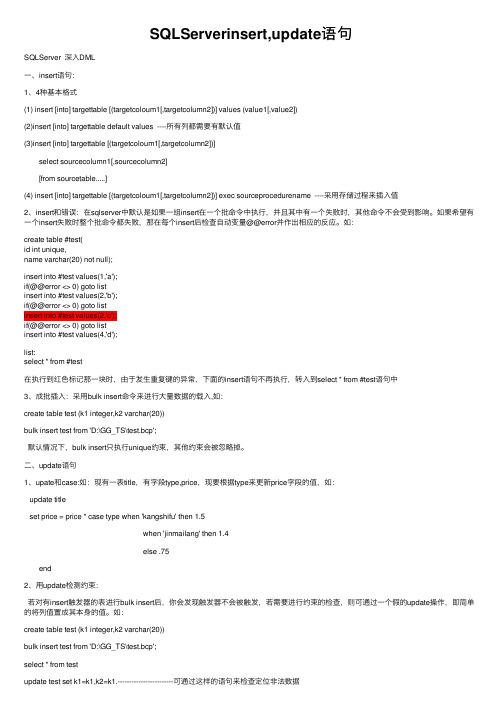
SQLServerinsert,update语句SQLServer 深⼊DML⼀、insert语句:1、4种基本格式(1) insert [into] targettable [(targetcoloum1[,targetcolumn2])] values (value1[,value2])(2)insert [into] targettable default values ----所有列都需要有默认值(3)insert [into] targettable [(targetcoloum1[,targetcolumn2])] select sourcecolumn1[,sourcecolumn2] [from sourcetable.....](4) insert [into] targettable [(targetcoloum1[,targetcolumn2])] exec sourceprocedurename ----采⽤存储过程来插⼊值2、insert和错误:在sqlserver中默认是如果⼀组insert在⼀个批命令中执⾏,并且其中有⼀个失败时,其他命令不会受到影响。
如果希望有⼀个insert失败时整个批命令都失败,那在每个insert后检查⾃动变量@@error并作出相应的反应。
如:create table #test(id int unique,name varchar(20) not null);insert into #test values(1,'a');if(@@error <> 0) goto listinsert into #test values(2,'b');if(@@error <> 0) goto listinsert into #test values(2,'c');if(@@error <> 0) goto listinsert into #test values(4,'d');list:select * from #test在执⾏到红⾊标记那⼀块时,由于发⽣重复键的异常,下⾯的insert语句不再执⾏,转⼊到select * from #test语句中3、成批插⼊:采⽤bulk insert命令来进⾏⼤量数据的载⼊,如:create table test (k1 integer,k2 varchar(20))bulk insert test from 'D:\GG_TS\test.bcp';默认情况下,bulk insert只执⾏unique约束,其他约束会被忽略掉。
mssqlserver insert into 语句的三种写法

mssqlserver insert into 语句的三种写法MSSQLServer是一种常用的关系型数据库管理系统,它支持使用SQL语言进行数据的增删改查操作。
其中,insert into语句是用于向数据库表中插入新记录的语句。
本文将深入探讨MSSQLServer中insert into语句的三种写法,分别是使用完整列名、省略列名和使用子查询。
单表插入数据是数据库应用中最常见的操作之一,它允许我们将新的数据记录插入到已存在的表格中。
无论是新建的表格还是已经存在的表格,我们都可以使用insert into语句来实现插入操作。
下面,我们将详细介绍这三种写法。
# 第一种写法:使用完整列名第一种常见的insert into语句写法是使用完整列名。
这种写法适用于当我们要插入的数据与表格的列一一对应,并且按照表格中列的顺序依次插入。
示例:INSERT INTO 表名(列1, 列2, 列3, ...)VALUES (值1, 值2, 值3, ...)在上述示例中,我们首先指定了要插入数据的表名,然后在括号中列出了表中的所有列名。
紧接着,在VALUES关键字后面用逗号分隔列值。
这里的列值应与列名的顺序相对应。
例如,我们有一个名为"customers"的表,它包含"customer_id"、"customer_name"和"address"三个列。
如果我们要向该表中插入新的客户信息,可以使用以下命令:INSERT INTO customers (customer_id, customer_name, address) VALUES (1, 'John Smith', '123 Main St')这样就向表"customers"中插入了一条新纪录,该记录的"customer_id"为1,"customer_name"为'John Smith',"address"为'123 Main St'。
sql语句insert_into用法_概述及举例说明

sql语句insert into用法概述及举例说明1. 引言1.1 概述SQL是一种用于管理和查询关系型数据库的编程语言。
在SQL中,INSERT INTO 语句用于向表中插入新的行数据。
它是SQL语句中最常用的之一,因为它可以帮助我们往表中添加数据。
1.2 文章结构本文将介绍INSERT INTO语句的基本语法和用法,并通过举例说明来更好地理解。
首先,我们将详细讨论如何插入单行数据、插入多行数据以及使用默认值插入数据的方法。
然后,我们将通过三个具体示例对这些概念进行实际操作。
1.3 目的本文旨在帮助读者全面了解和掌握SQL语句INSERT INTO的使用方法。
通过深入探讨其基本概念和示例操作,读者能够清楚地理解如何向数据库表中插入新纪录,并能够根据实际需求合理运用相关技巧。
以上是文章“1. 引言”部分内容,请注意以普通文本格式回答,不要包含任何网址或markdown格式内容。
2. SQL语句INSERT INTO用法2.1 插入单行数据在SQL中,使用INSERT INTO语句可以向表中插入一条数据。
INSERT INTO 语句的基本语法如下:```INSERT INTO 表名(列1, 列2, 列3, ...)VALUES (值1, 值2, 值3, ...);```其中,表名代表要插入数据的目标表格名称;括号内的列1、列2、列3等代表要插入数据的目标列名称;VALUES关键字后面括号内的值1、值2、值3等为具体要插入的数值。
例如,我们有一个名为"students"的表格,它包含"id"、"name"和"age"三个列。
现在我们想向该表格中插入一条记录,id为101,姓名为张三,年龄为20。
可以使用如下SQL语句进行插入操作:```INSERT INTO students (id, name, age)VALUES (101, '张三', 20);```2.2 插入多行数据除了插入单行数据外,还可以使用INSERT INTO语句一次性插入多行数据。
SqlServer系列:Insert语句
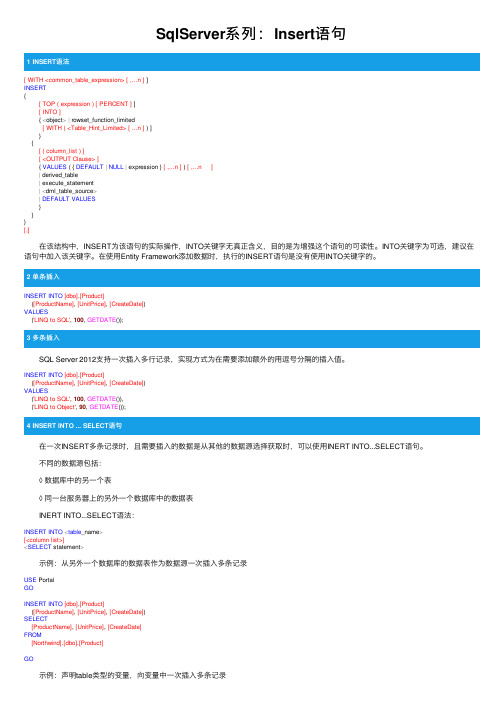
SqlServer系列:Insert语句[ WITH <common_table_expression> [ ,...n ] ]INSERT{[ TOP ( expression ) [ PERCENT ] ][ INTO ]{ <object>| rowset_function_limited[ WITH ( <Table_Hint_Limited> [ ...n ] ) ]}{[ ( column_list ) ][ <OUTPUT Clause> ]{ VALUES ( { DEFAULT|NULL| expression } [ ,...n ] ) [ ,...n ]| derived_table| execute_statement|<dml_table_source>|DEFAULT VALUES}}}[;] 在该结构中,INSERT为该语句的实际操作,INTO关键字⽆真正含义,⽬的是为增强这个语句的可读性。
INTO关键字为可选,建议在语句中加⼊该关键字。
在使⽤Entity Framework添加数据时,执⾏的INSERT语句是没有使⽤INTO关键字的。
2INSERT INTO[dbo].[Product]([ProductName], [UnitPrice], [CreateDate])VALUES('LINQ to SQL', 100, GETDATE());3 SQL Server 2012⽀持⼀次插⼊多⾏记录,实现⽅式为在需要添加额外的⽤逗号分隔的插⼊值。
INSERT INTO[dbo].[Product]([ProductName], [UnitPrice], [CreateDate])VALUES('LINQ to SQL', 100, GETDATE()),('LINQ to Object', 90, GETDATE()); 在⼀次INSERT多条记录时,且需要插⼊的数据是从其他的数据源选择获取时,可以使⽤INERT INTO...SELECT语句。
SQLServer使用一个语句块批量插入多条记录的三种方法
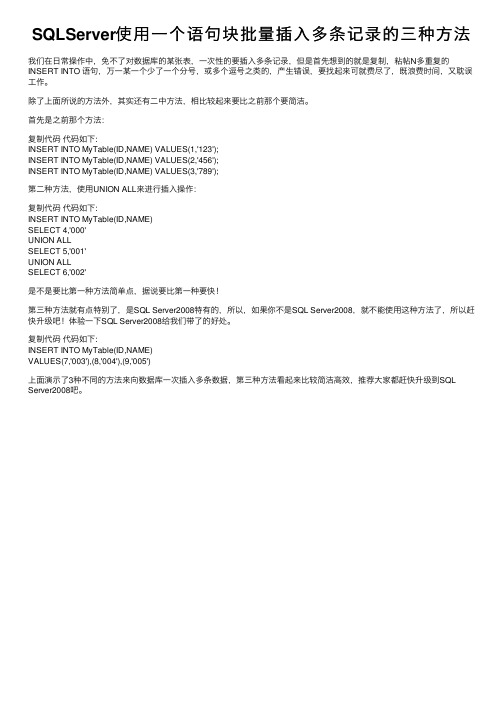
SQLServer使⽤⼀个语句块批量插⼊多条记录的三种⽅法我们在⽇常操作中,免不了对数据库的某张表,⼀次性的要插⼊多条记录,但是⾸先想到的就是复制,粘帖N多重复的INSERT INTO 语句,万⼀某⼀个少了⼀个分号,或多个逗号之类的,产⽣错误,要找起来可就费尽了,既浪费时间,⼜耽误⼯作。
除了上⾯所说的⽅法外,其实还有⼆中⽅法,相⽐较起来要⽐之前那个要简洁。
⾸先是之前那个⽅法:复制代码代码如下:INSERT INTO MyTable(ID,NAME) VALUES(1,'123');INSERT INTO MyTable(ID,NAME) VALUES(2,'456');INSERT INTO MyTable(ID,NAME) VALUES(3,'789');第⼆种⽅法,使⽤UNION ALL来进⾏插⼊操作:复制代码代码如下:INSERT INTO MyTable(ID,NAME)SELECT 4,'000'UNION ALLSELECT 5,'001'UNION ALLSELECT 6,'002'是不是要⽐第⼀种⽅法简单点,据说要⽐第⼀种要快!第三种⽅法就有点特别了,是SQL Server2008特有的,所以,如果你不是SQL Server2008,就不能使⽤这种⽅法了,所以赶快升级吧!体验⼀下SQL Server2008给我们带了的好处。
复制代码代码如下:INSERT INTO MyTable(ID,NAME)VALUES(7,'003'),(8,'004'),(9,'005')上⾯演⽰了3种不同的⽅法来向数据库⼀次插⼊多条数据,第三种⽅法看起来⽐较简洁⾼效,推荐⼤家都赶快升级到SQL Server2008吧。
sqlserver insert语句
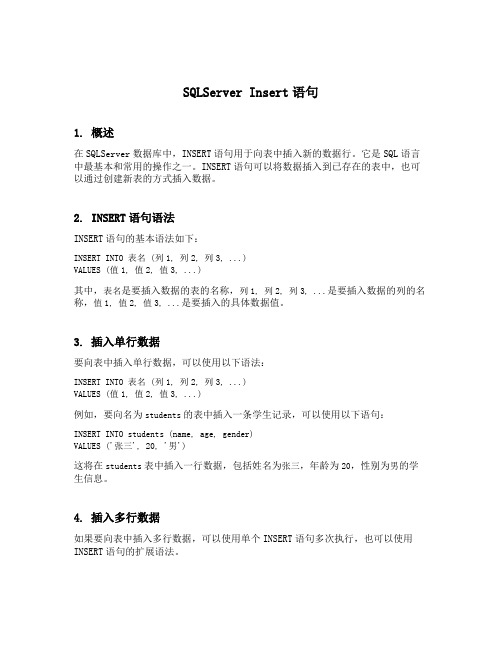
SQLServer Insert语句1. 概述在SQLServer数据库中,INSERT语句用于向表中插入新的数据行。
它是SQL语言中最基本和常用的操作之一。
INSERT语句可以将数据插入到已存在的表中,也可以通过创建新表的方式插入数据。
2. INSERT语句语法INSERT语句的基本语法如下:INSERT INTO 表名 (列1, 列2, 列3, ...)VALUES (值1, 值2, 值3, ...)其中,表名是要插入数据的表的名称,列1, 列2, 列3, ...是要插入数据的列的名称,值1, 值2, 值3, ...是要插入的具体数据值。
3. 插入单行数据要向表中插入单行数据,可以使用以下语法:INSERT INTO 表名 (列1, 列2, 列3, ...)VALUES (值1, 值2, 值3, ...)例如,要向名为students的表中插入一条学生记录,可以使用以下语句:INSERT INTO students (name, age, gender)VALUES ('张三', 20, '男')这将在students表中插入一行数据,包括姓名为张三,年龄为20,性别为男的学生信息。
4. 插入多行数据如果要向表中插入多行数据,可以使用单个INSERT语句多次执行,也可以使用INSERT语句的扩展语法。
4.1 多次执行INSERT语句可以多次执行INSERT语句来插入多行数据。
例如,要向students表中插入三条学生记录,可以使用以下语句:INSERT INTO students (name, age, gender)VALUES ('张三', 20, '男')INSERT INTO students (name, age, gender)VALUES ('李四', 22, '女')INSERT INTO students (name, age, gender)VALUES ('王五', 21, '男')这将分别插入三条学生记录到students表中。
sql server批量插入数据insert into写法
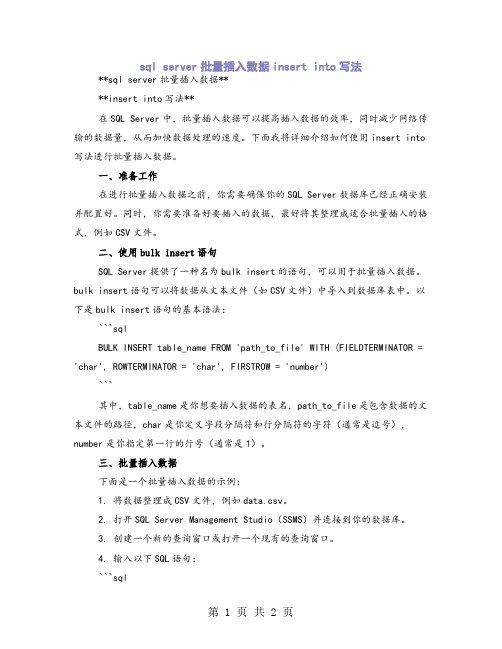
sql server批量插入数据insert into写法**sql server批量插入数据****insert into写法**在SQL Server中,批量插入数据可以提高插入数据的效率,同时减少网络传输的数据量,从而加快数据处理的速度。
下面我将详细介绍如何使用insert into 写法进行批量插入数据。
一、准备工作在进行批量插入数据之前,你需要确保你的SQL Server数据库已经正确安装并配置好。
同时,你需要准备好要插入的数据,最好将其整理成适合批量插入的格式,例如CSV文件。
二、使用bulk insert语句SQL Server提供了一种名为bulk insert的语句,可以用于批量插入数据。
bulk insert语句可以将数据从文本文件(如CSV文件)中导入到数据库表中。
以下是bulk insert语句的基本语法:```sqlBULK INSERT table_name FROM 'path_to_file' WITH (FIELDTERMINATOR = 'char', ROWTERMINATOR = 'char', FIRSTROW = 'number')```其中,table_name是你想要插入数据的表名,path_to_file是包含数据的文本文件的路径,char是你定义字段分隔符和行分隔符的字符(通常是逗号),number是你指定第一行的行号(通常是1)。
三、批量插入数据下面是一个批量插入数据的示例:1. 将数据整理成CSV文件,例如data.csv。
2. 打开SQL Server Management Studio(SSMS)并连接到你的数据库。
3. 创建一个新的查询窗口或打开一个现有的查询窗口。
4. 输入以下SQL语句:```sqlBULK INSERT mytable FROM 'data.csv' WITH (FIELDTERMINATOR =',' ,ROWTERMINATOR = '\n',FIRSTROW = 2)```其中,mytable是你想要插入数据的表名。
sqlserver数据库导出表里所有数据成insert语句

sqlserver数据库导出表⾥所有数据成insert语句有时候,我们想把数据库的某张表⾥的所有数据导⼊到另外⼀个数据库或另外⼀台计算机上的数据库,对于sql server有这样的⼀种⽅法下⾯我以sql server 2008 R2,数据库是Northwind数据库为例,⽬标:把Northwind数据库的Orders表导出成insert语句。
第⼀步:选择Northwind数据库,右键-任务-⽣成脚本:第⼆步:在弹出的“⽣成和发布脚本”的简介窗⼝,按“下⼀步”按钮:第三步:在“选择对象”窗⼝,选中“选择特定数据库对象”,展开表,勾选要⽣成insert语句的表,我这⾥选的是order表,按“下⼀步”按钮:第四步:在弹出的“设置脚本编写选项”窗⼝,按“⾼级”按钮,在弹出的“⾼级脚本编写选项”中下拉下拉条⾄底部,设置“要编写脚本的数据类型”为“仅限数据”(“仅限数据”是只导出数据为insert语句,如果是导出表结构的话选择“仅限架构”,选择“架构和数据”则架构和insert语句都⽣成),按“确定”按钮:第五步:在“设置脚本编写选项”窗⼝,“指定如何保存或发布脚本”的“输出类型”选中“将脚本保存到特定位置”,勾选“保存到⽂件”,则可以指定⼀个保存的路径,保存为.sql⽂件,勾选“保存到新建查询窗⼝”,则会新打开⼀个查询窗⼝,把所有insert 语句放到新查询窗⼝:第六步:在“设置脚本编写选项”窗⼝,按“下⼀步”按钮,弹出:第七步:在“摘要”窗⼝,按“下⼀步”按钮:第⼋步:在“保存或发布脚本”窗⼝,按“完成”按钮:最终会⾃动新建⼀个查询窗⼝,order表⾥的所有数据都转换成insert语句。
=====================================================================================将表⾥的数据批量⽣成INSERT语句的存储过程增强版有时候,我们需要将某个表⾥的数据全部或者根据查询条件导出来,迁移到另⼀个相同结构的库中⽬前SQL Server⾥⾯是没有相关的⼯具根据查询条件来⽣成INSERT语句的,只有借助第三⽅⼯具(third party tools)这种脚本⽹上也有很多,但是⽹上的脚本还是⽋缺⼀些规范和功能,例如:我只想导出特定查询条件的数据,⽹上的脚本都是导出全表数据如果表很⼤,对性能会有很⼤影响这⾥有⼀个存储过程(适⽤于SQLServer2005 或以上版本)-- =============================================-- Author: <桦仔>-- Blog: </lyhabc/>-- Create date: <2014/10/18>-- Description: <根据查询条件导出表数据的insert脚本>-- =============================================CREATE PROCEDURE[InsertGenerator](@tableName NVARCHAR(100),-- the table name@whereClause NVARCHAR(MAX),--col1=1@includeIdentity INT-- include identity column(1:yes,0:no))AS--of an INSERT DML statement.DECLARE@string NVARCHAR(MAX) --for storing the first half of INSERT statementDECLARE@stringData NVARCHAR(MAX) --for storing the data (VALUES) related statementDECLARE@dataType NVARCHAR(20) --data types returned for respective columnsDECLARE@schemaName NVARCHAR(20) --schema name returned from sys.schemasDECLARE@schemaNameCount int--shema countDECLARE@QueryString NVARCHAR(MAX) -- provide for the whole query,DECLARE@identity INT--identity column(1:yes,0:no)set@QueryString=''--如果有多个schema,选择其中⼀个schemaSELECT@schemaNameCount=COUNT(*)FROM sys.tables tINNER JOIN sys.schemas s ON t.schema_id = s.schema_idWHERE =@tableNameWHILE(@schemaNameCount>0)BEGIN--如果有多个schema,依次指定select@schemaName= namefrom(SELECT ROW_NUMBER() over(order by s.schema_id) RowID,FROM sys.tables tINNER JOIN sys.schemas s ON t.schema_id = s.schema_idWHERE =@tableName) as vwhere RowID=@schemaNameCount--Declare a cursor to retrieve column specific information--for the specified tableDECLARE cursCol CURSOR FAST_FORWARDFORSELECTclmns.[name]AS[column_name],usrt.[name]AS[data_type],CAST(COLUMNPROPERTY(clmns.id, clmns.[name], N'IsIdentity') AS int) AS[Identity]FROM dbo.sysobjects AS tbl WITH (NOLOCK)INNER JOIN dbo.syscolumns AS clmns WITH (NOLOCK) ON clmns.id=tbl.idLEFT JOIN dbo.systypes AS usrt WITH (NOLOCK) ON usrt.xusertype = clmns.xusertypeLEFT JOIN dbo.sysusers AS sclmns WITH (NOLOCK) ON sclmns.uid = usrt.uidLEFT JOIN dbo.systypes AS baset WITH (NOLOCK) ON baset.xusertype = clmns.xtype and baset.xusertype = baset.xtype LEFT JOIN dbo.syscomments AS defaults WITH (NOLOCK) ON defaults.id = clmns.cdefaultLEFT JOIN dbo.syscomments AS cdef WITH (NOLOCK) ON cdef.id = clmns.id AND cdef.number= clmns.colidWHERE (tbl.[type]='U') AND (tbl.[name]=@tableName AND SCHEMA_NAME(tbl.uid)=@schemaName) AND CAST(COLUMNPROPERTY(clmns.id, clmns.[name], N'IsIdentity') AS int)=@includeIdentity ORDER BY tbl.[name], clmns.colorderOPEN cursColSET@string='INSERT INTO ['+@schemaName+'].['+@tableName+']('SET@stringData=''DECLARE@colName NVARCHAR(500)FETCH NEXT FROM cursCol INTO@colName, @dataType,@identityPRINT@schemaNamePRINT@colNameIF@@fetch_status<>0BEGINPRINT'Table '+@tableName+' not found, processing skipped.'CLOSE curscolDEALLOCATE curscolRETURNENDWHILE@@FETCH_STATUS=0BEGINIF@dataType IN ( 'varchar', 'char', 'nchar', 'nvarchar' )BEGINSET@stringData=@stringData+'''''''''+isnull('+@colName+','''')+'''''',''+'ENDELSEIF@dataType IN ( 'text', 'ntext' ) --if the datatype--is text or something elseBEGINSET@stringData=@stringData+'''''''''+isnull(cast('+@colName+' as nvarchar(max)),'''')+'''''',''+'END--from varchar implicitlyBEGINSET@stringData=@stringData+'''convert(money,''''''+isnull(cast('+@colName+' as nvarchar(max)),''0.0000'')+''''''),''+'ENDELSEIF@dataType='datetime'BEGIN-- SET @stringData = @stringData-- + '''convert(datetime,''''''+--isnull(cast(' + @colName + ' as nvarchar(max)),''null'')+''''''),''+'SET@stringData=@stringData+'COALESCE(''''''''+CONVERT(varchar(max),'+@colName+',120)+'''''''',''NULL'')+'',''+'ENDELSEIF@dataType='image'BEGINSET@stringData=@stringData+'''''''''+isnull(cast(convert(varbinary,'+@colName+')as varchar(6)),''0'')+'''''',''+'ENDELSE--presuming the data type is int,bit,numeric,decimalBEGINSET@stringData=@stringData+'''''''''+isnull(cast('+@colName+' as nvarchar(max)),''0'')+'''''',''+'ENDSET@string=@string+'['+@colName+']'+','FETCH NEXT FROM cursCol INTO@colName, @dataType,@identityEND--After both of the clauses are built, the VALUES clause contains a trailing comma which needs to be replaced with a single quote. The prefixed clause will only face removal of the trailing comma. DECLARE@Query NVARCHAR(MAX) -- provide for the whole query,-- you may increase the sizePRINT@whereClauseIF ( @whereClause IS NOT NULLAND@whereClause<>'')BEGINPRINT'stringData:'+@stringDataSET@query='SELECT '''+SUBSTRING(@string, 0, LEN(@string))+') VALUES(''+ '+SUBSTRING(@stringData, 0,LEN(@stringData) -2)+'''+'')''FROM '+@schemaName+'.'+@tableName+' WHERE '+@whereClausePRINT@query-- EXEC sp_executesql @query --load and run the built query--Eventually, close and de-allocate the cursor created for columns information.ENDELSEBEGINSET@query='SELECT '''+SUBSTRING(@string, 0, LEN(@string))+') VALUES(''+ '+SUBSTRING(@stringData, 0,LEN(@stringData) -2)+'''+'')''FROM '+@schemaName+'.'+@tableNameENDCLOSE cursColDEALLOCATE cursColSET@schemaNameCount=@schemaNameCount-1IF(@schemaNameCount=0)BEGINSET@QueryString=@QueryString+@queryENDELSEBEGINSET@QueryString=@QueryString+@query+' UNION ALL 'END--SET @QueryString=REPLACE(@QueryString,'convert(datetime,''NULL'')',NULL)PRINT CONVERT(VARCHAR(MAX),@schemaNameCount)+'---'+@QueryStringEND--PRINT @QueryStringEXEC sp_executesql @QueryString--load and run the built query--Eventually, close and de-allocate the cursor created for columns information.这⾥要声明⼀下,如果你有多个schema,并且每个schema下⾯都有同⼀张表,那么脚本只会⽣成其中⼀个schema下⾯的表insert脚本⽐如我现在有三个schema,下⾯都有customer这个表CREATE SCHEMA testCREATE TABLE test.[customer](city int,region int)CREATE SCHEMA test1CREATE TABLE test1.[customer](city int,region int)在执⾏脚本的时候他只会⽣成dbo这个schema下⾯的表insert脚本INSERT INTO[dbo].[customer]([city],[region]) VALUES('1','2')这个脚本有⼀个缺陷⽆论你的表的字段是什麽数据类型,导出来的时候只能是字符表结构CREATE TABLE[dbo].[customer](city int,region int)导出来的insert脚本INSERT INTO[dbo].[customer]([city],[region]) VALUES('1','2')我这⾥演⽰⼀下怎麽⽤有两种⽅式1、导全表数据InsertGenerator 'customer', null或InsertGenerator 'customer', ''2、根据查询条件导数据InsertGenerator 'customer', 'city=3'或者InsertGenerator 'customer', 'city=3 and region=8'点击⼀下,选择全部然后复制新建⼀个查询窗⼝,然后粘贴其实SQLServer的技巧有很多最后,⼤家可以看⼀下代码,⾮常简单,如果要⽀持SQLServer2000,只要改⼀下代码就可以了补充:创建⼀张测试表CREATE TABLE testinsert (id INT,name VARCHAR(100),cash MONEY,dtime DATETIME) INSERT INTO[dbo].[testinsert]( [id], [name], [cash], [dtime] )VALUES ( 1, -- id - int'nihao', -- name - varchar(100)8.8, -- cash - moneyGETDATE() -- dtime - datetime)SELECT*FROM[dbo].[testinsert]测试InsertGenerator 'testinsert' ,''InsertGenerator 'testinsert' ,'name=''nihao'''InsertGenerator 'testinsert' ,'name=''nihao'' and cash=8.8'datetime类型会有⼀些问题⽣成的结果会⾃动帮你转换INSERT INTO[dbo].[testinsert]([id],[name],[cash],[dtime]) VALUES('1','nihao',convert(money,'8.80'),convert(datetime,'02 8 2015 5:17PM'))群⾥的⼈共享的另⼀个脚本IF OBJECT_ID('spGenInsertSQL','P') IS NOT NULLDROP PROC spGenInsertSQLGOCREATE proc spGenInsertSQL (@tablename varchar(256),@number BIGINT,@whereClause NVARCHAR(MAX))asbegindeclare@sql varchar(8000)declare@sqlValues varchar(8000)set@sql=' ('set@sqlValues='values (''+'select@sqlValues=@sqlValues+ cols +' + '','' + ' ,@sql=@sql+'['+ name +'],'from(select casewhen xtype in (48,52,56,59,60,62,104,106,108,122,127)then'case when '+ name +' is null then ''NULL'' else '+'cast('+ name +' as varchar)'+' end'when xtype in (58,61,40,41,42)then'case when '+ name +' is null then ''NULL'' else '+''''''''' + '+'cast('+ name +' as varchar)'+'+'''''''''+' end'when xtype in (167)then'case when '+ name +' is null then ''NULL'' else '+''''''''' + '+'replace('+ name+','''''''','''''''''''')'+'+'''''''''+' end'when xtype in (231)then'case when '+ name +' is null then ''NULL'' else '+'''N'''''' + '+'replace('+ name+','''''''','''''''''''')'+'+'''''''''+' end'when xtype in (175)then'case when '+ name +' is null then ''NULL'' else '+''''''''' + '+'cast(replace('+ name+','''''''','''''''''''') as Char('+cast(length as varchar) +'))+'''''''''+' end' when xtype in (239)then'case when '+ name +' is null then ''NULL'' else '+'''N'''''' + '+'cast(replace('+ name+','''''''','''''''''''') as Char('+cast(length as varchar) +'))+'''''''''+' end' else'''NULL'''end as Cols,namefrom syscolumnswhere id =object_id(@tablename)) TIF (@number!=0AND@number IS NOT NULL)BEGINset@sql='select top '+CAST(@number AS VARCHAR(6000))+'''INSERT INTO ['+@tablename+']'+left(@sql,len(@sql)-1)+') '+left(@sqlValues,len(@sqlValues)-4) +')'' from '+@tablename print@sqlENDELSEBEGINset@sql='select ''INSERT INTO ['+@tablename+']'+left(@sql,len(@sql)-1)+') '+left(@sqlValues,len(@sqlValues)-4) +')'' from '+@tablenameprint@sqlENDPRINT@whereClauseIF ( @whereClause IS NOT NULL AND@whereClause<>'')BEGINset@sql=@sql+' where '+@whereClauseprint@sqlENDexec (@sql)endGOView Code调⽤⽰例--⾮dbo默认架构需注意--⽀持数据类型:bigint,int, bit,char,datetime,date,time,decimal,money, nvarchar(50),tinyint, nvarchar(max),varchar(max),datetime2--调⽤⽰例如果top⾏或者where条件为空,只需要把参数填上nullspGenInsertSQL 'customer'--表名, 2--top ⾏数, 'city=3 and didian=''⼤连'''--where 条件--导出全表 where条件为空spGenInsertSQL 'customer'--表名, null--top ⾏数,null--where 条件INSERT INTO[Department] ([DepartmentID],[Name],[GroupName],[Company],[ModifiedDate]) values (1,N'售后部',N'销售组',N'中国你好有限公司XX分公司','05 5 2015 5:58PM') INSERT INTO[Department] ([DepartmentID],[Name],[GroupName],[Company],[ModifiedDate]) values (2,N'售后部',N'销售组',N'中国你好有限公司XX分公司','05 5 2015 5:58PM')。
sqlsever insert语句
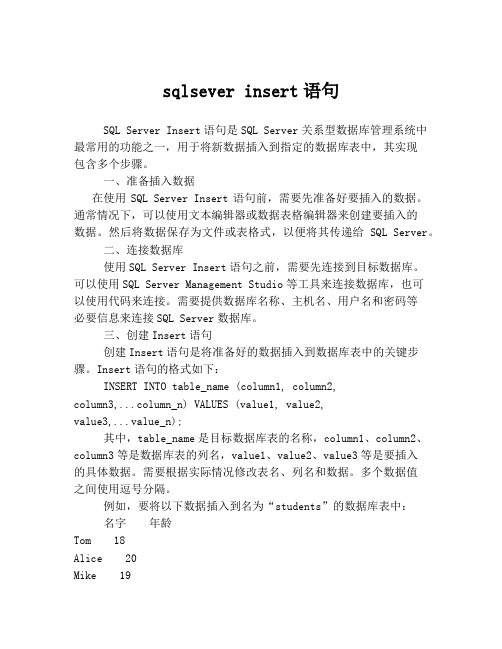
sqlsever insert语句SQL Server Insert语句是SQL Server关系型数据库管理系统中最常用的功能之一,用于将新数据插入到指定的数据库表中,其实现包含多个步骤。
一、准备插入数据在使用SQL Server Insert语句前,需要先准备好要插入的数据。
通常情况下,可以使用文本编辑器或数据表格编辑器来创建要插入的数据。
然后将数据保存为文件或表格式,以便将其传递给SQL Server。
二、连接数据库使用SQL Server Insert语句之前,需要先连接到目标数据库。
可以使用SQL Server Management Studio等工具来连接数据库,也可以使用代码来连接。
需要提供数据库名称、主机名、用户名和密码等必要信息来连接SQL Server数据库。
三、创建Insert语句创建Insert语句是将准备好的数据插入到数据库表中的关键步骤。
Insert语句的格式如下:INSERT INTO table_name (column1, column2,column3,...column_n) VALUES (value1, value2,value3,...value_n);其中,table_name是目标数据库表的名称,column1、column2、column3等是数据库表的列名,value1、value2、value3等是要插入的具体数据。
需要根据实际情况修改表名、列名和数据。
多个数据值之间使用逗号分隔。
例如,要将以下数据插入到名为“students”的数据库表中:名字年龄Tom 18Alice 20Mike 19可以使用以下SQL Server Insert语句:INSERT INTO students (name, age) VALUES ('Tom', 18),('Alice', 20), ('Mike', 19);其中,name和age是表的列名,'Tom'、18、'Alice'等是具体的数据值。
sql语句中使用insert_select语句创建表_概述说明

sql语句中使用insert select语句创建表概述说明1. 引言1.1 概述本文旨在探讨如何在SQL语句中使用INSERT SELECT语句创建表。
INSERT SELECT语句是一种强大的功能,可以同时插入和选择数据,用于将查询结果插入到新创建的表中。
通过这种方式,我们能够方便地创建包含特定数据的表,并可以根据需要灵活选择要插入的字段。
1.2 文章结构本文将分为以下几个部分进行说明。
首先,我们会对INSERT SELECT语句进行概述,介绍其基本功能和用途。
然后,我们会详细讲解创建表的基本语法和用法示例,以帮助读者更好地理解如何使用该语句来创建表。
接着,我们还会介绍如何插入数据到新创建的表中,包括插入部分字段数据和插入全部字段数据两种情况。
此外,在文章的后半部分,我们还会针对一些可能遇到的错误提供解决方案,并列出使用INSERT SELECT语句创建表时需要注意的一些细节事项。
最后,在结论部分,我们将总结使用INSERT SELECT语句创建表的优势和适用场景,并展望其未来发展趋势。
1.3 目的通过本文的阐述,读者能够全面了解并掌握在SQL语句中使用INSERT SELECT 语句创建表的方法和技巧。
这将帮助读者在实际应用中更高效地创建表格、插入数据,并能够避免一些常见的错误。
同时,通过对使用INSERT SELECT语句创建表的优势和适用场景进行总结,读者还能够更好地评估其在实际项目中的应用价值,并为未来的发展做出合理的选择。
以上就是“1. 引言”部分的内容,请根据需要进行修改和完善。
2. SQL语句中使用INSERT SELECT语句创建表:2.1 INSERT SELECT语句的概述:在SQL中,可以使用INSERT SELECT语句将一张已有表中的数据插入到新创建的表中。
这种方法既能够创建一个新表,同时将源表的数据复制到新表中。
2.2 创建表的基本语法和用途:要使用INSERT SELECT语句创建新表并插入数据,需要按照以下基本语法进行操作:```sqlCREATE TABLE 新表名ASSELECT 列名1, 列名2, ...FROM 源表名;```这里,新建的表会包含与SELECT子句中指定列相同名称和数据类型的字段。
sql中insert的用法(一)

sql中insert的用法(一)SQL中INSERT的用法详解1. INSERT INTO语句•使用INSERT INTO语句可以向表中插入一条或多条记录。
•语法: INSERT INTO 表名 (列1, 列2, 列3, ...) VALUES (值1, 值2, 值3, ...);•示例:INSERT INTO students (name, age, gender) V ALUES ('John', 20, 'Male');2. 插入多条记录•使用INSERT INTO语句可以同时插入多条记录。
•语法:INSERT INTO 表名 (列1, 列2, 列3, ...) VALUES (值1, 值2, 值3, ...),(值4, 值5, 值6, ...),...(值n, 值n+1, 值n+2, ...);•示例:INSERT INTO students (name, age, gender) VALUES ('John', 20, 'Male'), ('Emily', 22, 'Female'), ('Michael', 19, 'Male');3. 插入默认值•使用DEFAULT关键字可以插入默认值。
•示例:INSERT INTO students (name, age, gender, c ity)VALUES ('Jessica', 21, 'Female', DEFAULT);4. 插入查询结果•可以使用INSERT INTO语句插入另一个查询的结果。
•语法:INSERT INTO 表名 (列1, 列2, 列3, ...) SELECT 列1, 列2, 列3, ...FROM 另一个表WHERE 条件;•示例:INSERT INTO employees (name, age, departme nt)SELECT name, age, departmentFROM temp_employeesWHERE age > 25;5. 插入子查询结果•可以使用子查询的结果来作为INSERT INTO语句的值。
SQLServer中的XML数据进行insert、update、delete

SQLServer中的XML数据进⾏insert、update、deleteSQL Server 2005/2008增加了对XML数据的⽀持,同时也新增了⼏种操作XML的⽅法,本⽂主要以SQL Server 2008为例介绍如何对XML数据进⾏insert、update、delete。
SQL Server中新增加了XML.Modify()⽅法,分别为xml.modify(insert),xml.modify(delete),xml.modify(replace)对应XML的插⼊,删除和修改操作。
本⽂以下⾯XML为例,对三种DML进⾏说明:declare @XMLVar XML;SET @XMLVar= '<catalog><book category="ITPro"><title>Windows Step By Step</title><author>Bill Zack</author><price>49.99</price></book><book category="Developer"><title>Developing ADO .NET</title><author>Andrew Brust</author><price>39.93</price></book><book category="ITPro"><title>Windows Cluster Server</title><author>Stephen Forte</author><price>59.99</price></book></catalog>'1.XML.Modify(Insert)语句介绍A.利⽤as first,at last,before,after四个参数将元素插⼊指定的位置set @XMLVar.modify('insert <first name="at first" /> as first into (/catalog[1]/book[1])')set @XMLVar.modify('insert <last name="at last"/> as last into (/catalog[1]/book[1])')set @XMLVar.modify('insert <before name="before"/> before (/catalog[1]/book[1]/author[1])')set @XMLVar.modify('insert <after name="after"/> after (/catalog[1]/book[1]/author[1])')SELECT @XMLVar.query('/catalog[1]/book[1]');结果集为:1: <book category="ITPro">2: <first name="at first" />3: <title>Windows Step By Step</title>4: <before name="before" />5: <author>Bill Zack</author>6: <after name="after" />7: <price>49.99</price>8: <last name="at last" />9: </book>B.将多个元素插⼊⽂档中--⽅法⼀:利⽤变量进⾏插⼊DECLARE @newFeatures xml;SET @newFeatures = N'; <first>one element</first> <second>second element</second>'SET @XMLVar.modify(' )insert sql:variable("@newFeatures")into (/catalog[1]/book[1])'--⽅法⼆:直接插⼊set @XMLVar.modify(')insert (<first>one element</first>,<second>second element</second>)into (/catalog[1]/book[1]/author[1])'SELECT @XMLVar.query('/catalog[1]/book[1]');结果集为:1: <book category="ITPro">2: <title>Windows Step By Step</title>3: <author>Bill Zack4: <first>one element</first>5: <second>second element</second>6: </author>7: <price>49.99</price>8: <first>one element</first>9: <second>second element</second>10: </book>C.将属性插⼊⽂档中--使⽤变量插⼊declare @var nvarchar(10) = '变量插⼊'set @XMLVar.modify('insert (attribute var {sql:variable("@var")}))into (/catalog[1]/book[1])'--直接插⼊set @XMLVar.modify('insert (attribute name {"直接插⼊"}))into (/catalog[1]/book[1]/title[1])'--多值插⼊set @XMLVar.modify('insert (attribute Id {"多值插⼊1"},attribute name {"多值插⼊2"}) )into (/catalog[1]/book[1]/author[1])'SELECT @XMLVar.query('/catalog[1]/book[1]');结果集为:1: <book category="ITPro" var="变量插⼊">2: <title name="直接插⼊">Windows Step By Step</title>3: <author Id="多值插⼊1" name="多值插⼊2">Bill Zack</author>4: <price>49.99</price>5: </book>D.插⼊⽂本节点set @XMLVar.modify('insert text{"at first"} as first)into (/catalog[1]/book[1])'SELECT @XMLVar.query('/catalog[1]/book[1]');结果集为:1: <book category="ITPro">2: at first3: <title>Windows Step By Step</title>4: <author>Bill Zack</author>5: <price>49.99</price>6: </book>注意:插⼊本⽂同样具体 as first,as last,before,after四种选项,可以参考A中的使⽤⽅法E.插⼊注释节点set @XMLVar.modify(N'insert <!--插⼊评论-->before (/catalog[1]/book[1]/title[1])' )SELECT @XMLVar.query('/catalog[1]/book[1]');结果集为:1: <book category="ITPro">2: <!--插⼊评论-->3: <title>Windows Step By Step</title>4: <author>Bill Zack</author>5: <price>49.99</price>6: </book>注意插⼊注释节点同样具体 as first,as last,before,after四种选项,可以参考A中的使⽤⽅法F.插⼊处理指令set @XMLVar.modify('insert <?Program "Instructions.exe" ?>before (/catalog[1]/book[1]/title[1])' )SELECT @XMLVar.query('/catalog[1]/book[1]');结果集为:1: <book category="ITPro">2: <?Program "Instructions.exe" ?>3: <title>Windows Step By Step</title>4: <author>Bill Zack</author>5: <price>49.99</price>6: </book>注意插⼊处理指令同样具体 as first,as last,before,after四种选项,可以参考A中的使⽤⽅法G.根据 if 条件语句进⾏插⼊set @XMLVar.modify('insertif (/catalog[1]/book[1]/title[2]) thentext{"this is a 1 step"}else ( text{"this is a 2 step"} )into (/catalog[1]/book[1]/price[1])' )SELECT @XMLVar.query('/catalog[1]/book[1]');结果集为:1: <book category="ITPro">2: <title>Windows Step By Step</title>3: <author>Bill Zack</author>4: <price>49.99this is a 2 step</price>5: </book>2.XML.Modify(delete)语句介绍--删除属性set @XMLVar.modify('delete /catalog[1]/book[1]/@category')--删除节点set @XMLVar.modify('delete /catalog[1]/book[1]/title[1]')--删除内容set @XMLVar.modify('delete /catalog[1]/book[1]/author[1]/text()')--全部删除set @XMLVar.modify('delete /catalog[1]/book[2]')SELECT @XMLVar.query('/catalog[1]');结果集为:1: <catalog>2: <book>3: <author />4: <price>49.99</price>5: </book>6: <book category="ITPro">7: <title>Windows Cluster Server</title>8: <author>Stephen Forte</author>9: <price>59.99</price>10: </book>11: </catalog>3.XML.Modify(replace)语句介绍--替换属性set @XMLVar.modify(N'replace value of(/catalog[1]/book[1]/@category)with ("替换属性")' )--替换内容set @XMLVar.modify(N'replace value of(/catalog[1]/book[1]/author[1]/text()[1]) with("替换内容")' )--条件替换set @XMLVar.modify(N'replace value of (/catalog[1]/book[2]/@category) with(if(count(/catalog[1]/book)>4) then"条件替换1"else"条件替换2")' )SELECT @XMLVar.query('/catalog[1]'); 结果集为:1: <catalog>2: <book category="替换属性">3: <title>Windows Step By Step</title>4: <author>替换内容</author>5: <price>49.99</price>6: </book>7: <book category="条件替换2">8: <title>Developing ADO .NET</title>9: <author>Andrew Brust</author>10: <price>39.93</price>11: </book>12: <book category="ITPro">13: <title>Windows Cluster Server</title>14: <author>Stephen Forte</author>15: <price>59.99</price>16: </book>17: </catalog>。
SQLServerInsertinto添加数据
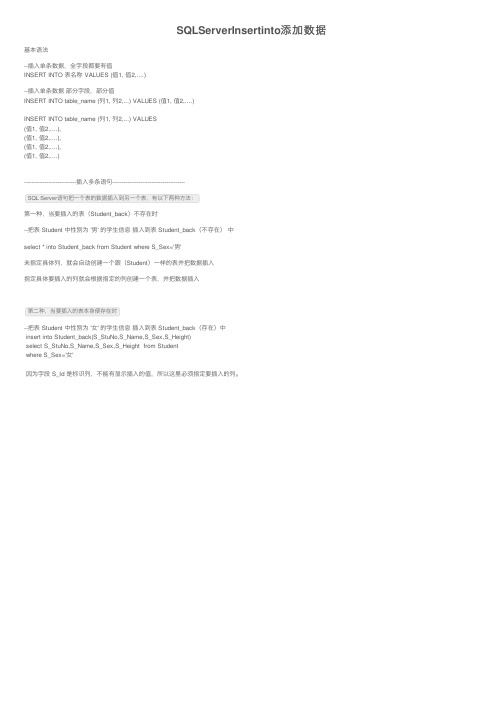
SQLServerInsertinto添加数据基本语法--插⼊单条数据,全字段都要有值INSERT INTO 表名称 VALUES (值1, 值2,....)--插⼊单条数据部分字段,部分值INSERT INTO table_name (列1, 列2,...) VALUES (值1, 值2,....)INSERT INTO table_name (列1, 列2,...) VALUES(值1, 值2,....),(值1, 值2,....),(值1, 值2,....),(值1, 值2,....)----------------------------插⼊多条语句---------------------------------------SQL Server语句把⼀个表的数据插⼊到另⼀个表,有以下两种⽅法:第⼀种,当要插⼊的表(Student_back)不存在时--把表 Student 中性别为 '男' 的学⽣信息插⼊到表 Student_back(不存在)中select * into Student_back from Student where S_Sex='男'未指定具体列,就会⾃动创建⼀个跟(Student)⼀样的表并把数据插⼊指定具体要插⼊的列就会根据指定的列创建⼀个表,并把数据插⼊第⼆种,当要插⼊的表本⾝便存在时--把表 Student 中性别为 '⼥' 的学⽣信息插⼊到表 Student_back(存在)中insert into Student_back(S_StuNo,S_Name,S_Sex,S_Height)select S_StuNo,S_Name,S_Sex,S_Height from Studentwhere S_Sex='⼥'因为字段 S_Id 是标识列,不能有显⽰插⼊的值,所以这⾥必须指定要插⼊的列。
SQLSERVER如何向表中插入数据
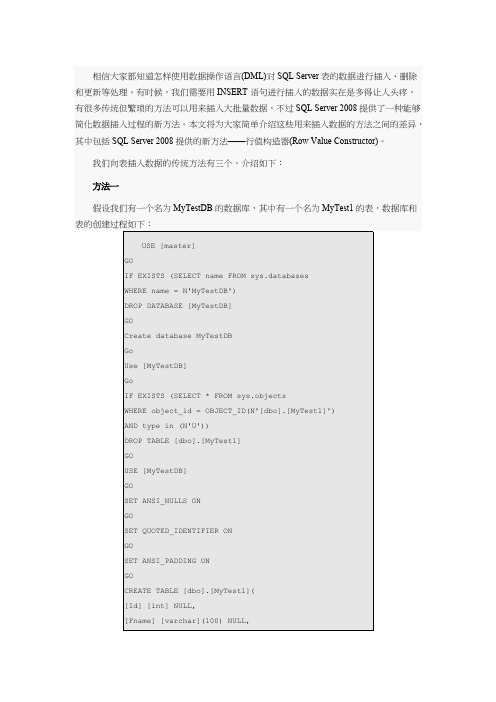
下面我们再用另外一种传统的插入方法同样添加5行数据,也就是使用带SELECT从句的INSERT SQL语句,脚本如下:insert into MyTest2 select 1 , 'John' , 'Smith' , 150000.00insert into MyTest2 select 2 , 'Hillary' , 'Swank' , 250000.00insert into MyTest2 select 3 , 'Elisa' , 'Smith' , 120000.00insert into MyTest2 select 4 , 'Liz' , 'Carleno' , 151000.00insert into MyTest2 select 5 , 'Tony' , 'Mcnamara' , 150300.00执行结果如下:(1 row(s) affected)(1 row(s) affected)(1 row(s) affected)(1 row(s) affected)(1 row(s) affected)方法三同样的,我们再假设上述的MyTestDB数据库中有表MyTest3,如下:下面我们用第三种传统的插入方法同样添加5行数据,这里使用的是带SELECT从句和UNION从句的INSERT SQL语句,脚本如下:insert into MyTest3select 1 , 'John' , 'Smith' , 150000.00union select 2 , 'Hillary' , 'Swank' , 250000.00union select 3 , 'Elisa' , 'Smith' , 120000.00union select 4 , 'Liz' , 'Carleno' , 151000.00union select 5 , 'Tony' , 'Mcnamara' , 150300.00执行结果如下:现在我们要用到SQL Server 2008中提供的新方法——行值构造器的插入SQL语句为上述表插入5行数据,这种方法可以在一个INSERT语句中一次性插入多行数据,脚本如下:insert into MyTest4 (id ,fname ,lname , salary) values(1 , 'John' , 'Smith' , 150000.00),(2 , 'Hillary' , 'Swank' , 250000.00),(3 , 'Elisa' , 'Smith' , 120000.00),(4 , 'Liz' , 'Carleno' , 151000.00),(5 , 'Tony' , 'Mcnamara' , 150300.00)执行结果如下:(5 row(s) affected)。
数据库中insert的用法 -回复
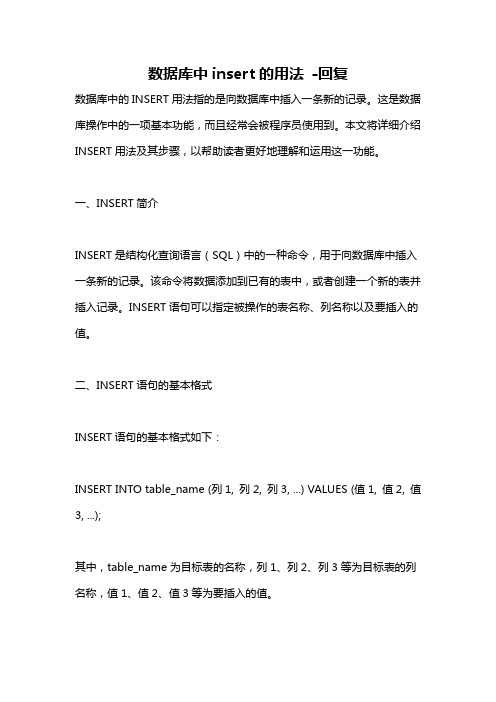
数据库中insert的用法-回复数据库中的INSERT用法指的是向数据库中插入一条新的记录。
这是数据库操作中的一项基本功能,而且经常会被程序员使用到。
本文将详细介绍INSERT用法及其步骤,以帮助读者更好地理解和运用这一功能。
一、INSERT简介INSERT是结构化查询语言(SQL)中的一种命令,用于向数据库中插入一条新的记录。
该命令将数据添加到已有的表中,或者创建一个新的表并插入记录。
INSERT语句可以指定被操作的表名称、列名称以及要插入的值。
二、INSERT语句的基本格式INSERT语句的基本格式如下:INSERT INTO table_name (列1, 列2, 列3, ...) VALUES (值1, 值2, 值3, ...);其中,table_name为目标表的名称,列1、列2、列3等为目标表的列名称,值1、值2、值3等为要插入的值。
三、INSERT的具体用法1. 插入单行记录要向数据库中插入一条新的记录,可以使用如下语句:INSERT INTO Employees (ID, Name, Age) VALUES (1, 'John Doe', 30);这条语句的意思是向名为Employees的表中插入一条记录,该记录包括ID、Name和Age这三个字段,并且分别插入了1、'John Doe'和30这三个值。
2. 插入多行记录可以同时插入多条记录,只需用逗号将各行的值分隔开即可,如下所示:INSERT INTO Employees (ID, Name, Age) VALUES(2, 'Jane Smith', 28),(3, 'David Johnson', 32),(4, 'Sarah Williams', 35);这条语句将依次插入四条记录到名为Employees的表中。
3. 插入部分字段如果不需要像上述例子中那样插入所有的字段,可以指定要插入的字段名称,如下所示:INSERT INTO Employees (ID, Name) VALUES (5, 'Michael Brown');这条语句只插入了ID和Name这两个字段,Age字段按照表的定义将使用默认值。
sqlserver表插入数据写法

sqlserver表插入数据写法在使用SQL Server数据库管理系统时,表是存储和组织数据的重要对象。
插入数据是在表中添加新记录的常见操作,而正确的插入语句写法对于数据的准确性和数据库性能至关重要。
本文将深入探讨SQL Server表插入数据的详细写法,包括基本的插入语句、常用插入方法和注意事项。
第一:基本插入语句在SQL Server中,使用INSERT INTO语句可以向表中插入新的记录。
基本插入语句的写法如下:sqlINSERT INTO表名(列1, 列2, 列3, ...)VALUES(值1, 值2, 值3, ...);其中,表名是目标表的名称,列1、列2等是要插入数据的列的名称,而值1、值2等则是对应列的实际值。
举例来说,如果有一个名为Employees的表,包含EmployeeID、FirstName和LastName等列,插入一条新员工记录的语句可以如下:sqlINSERT INTO Employees (EmployeeID, FirstName, LastName)VALUES(1, 'John', 'Doe');第二:使用默认值插入数据在某些情况下,表的某些列可能有默认值,而我们希望插入数据时使用这些默认值。
这时,可以省略插入语句中的列名和对应的值,数据库将使用列的默认值进行插入。
sqlINSERT INTO表名VALUES(值1, 值2, 值3, ...);例如,如果表Products中有一列CreateDate,其默认值为当前日期,可以使用如下语句插入数据:sqlINSERT INTO ProductsVALUES('ProductA', 100, 10.99, GETDATE());第三:插入查询结果有时,我们需要从一个表中选择数据并将其插入到另一个表中。
这时可以使用INSERT INTO的SELECT子句:sqlINSERT INTO目标表(列1, 列2, 列3, ...)SELECT列1, 列2, 列3, ...FROM源表WHERE条件;例如,将Customers表中所有城市为‘New York’的记录插入到NewYorkCustomers表中:sqlINSERT INTO NewYorkCustomers (CustomerID, CustomerName, City)SELECT CustomerID, CustomerName, CityFROM CustomersWHERE City ='New York';第四:批量插入数据在一次性插入大量数据时,使用INSERT INTO的VALUES子句可能效率较低。
sqlserver中insert插入date类数据的方法
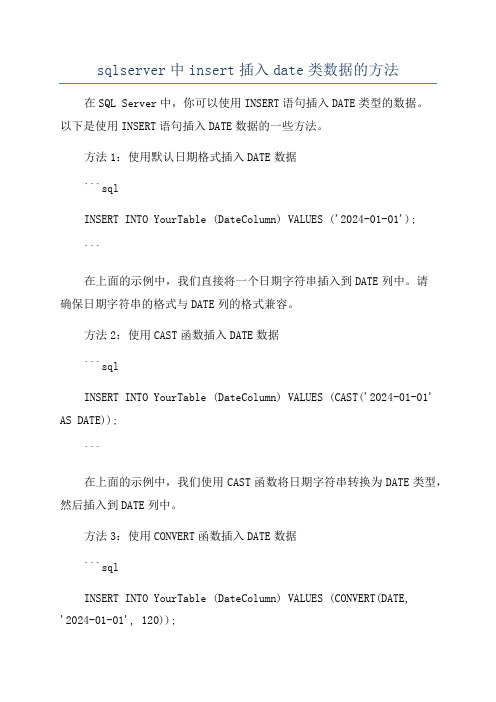
sqlserver中insert插入date类数据的方法在SQL Server中,你可以使用INSERT语句插入DATE类型的数据。
以下是使用INSERT语句插入DATE数据的一些方法。
方法1:使用默认日期格式插入DATE数据```sqlINSERT INTO YourTable (DateColumn) VALUES ('2024-01-01');```在上面的示例中,我们直接将一个日期字符串插入到DATE列中。
请确保日期字符串的格式与DATE列的格式兼容。
方法2:使用CAST函数插入DATE数据```sqlINSERT INTO YourTable (DateColumn) VALUES (CAST('2024-01-01' AS DATE));```在上面的示例中,我们使用CAST函数将日期字符串转换为DATE类型,然后插入到DATE列中。
方法3:使用CONVERT函数插入DATE数据```sqlINSERT INTO YourTable (DateColumn) VALUES (CONVERT(DATE,'2024-01-01', 120));```在上面的示例中,我们使用CONVERT函数将日期字符串转换为DATE 类型,并指定了转换的格式代码(120)。
请根据需要选择适当的格式代码。
有关日期格式代码的完整列表,请参阅SQL Server文档。
方法4:使用GETDATE函数插入当前日期```sqlINSERT INTO YourTable (DateColumn) VALUES (GETDATE();```在上面的示例中,我们使用GETDATE函数获取当前日期和时间,并将其插入到DATE列中。
请注意,GETDATE函数返回的是带有时间部分的DATETIME值。
如果你只想插入日期部分,可以使用CAST或CONVERT函数将其转换为DATE类型。
用INSERT语句插入记录SQLServer程序设计语言PPT课件

第4页/共9页
使用TOP关键字
• --下面的示例创建Newsudent表,并将s表中前2名学生的学号, 姓名数据插入到该表中。然后执行SELECT 语句以验证 Newsudent 表的内容。
select sno,sname from s INSERT Newsudent EXECUTE getstudent
第8页/共9页
感谢您的观看!
第9页/共9页
• 在选择列表中,必须为列起一个别名或指定新表的列的名字
USE northwind SELECT productname AS products
,unitprice AS price ,(unitprice * 1.1) AS tax INTO pricetable FROM products GO
CREATE TABLE Newsudent (sno varchar(10) primar y key, sname varchar(10))
INSERT TOP(2) INTO Newsudent SELECT sno,sname from s
第5页/共9页
使用 SELECT INTO 语句创建表
第6页/共9页
INSERT...E XECUTE('string') example
USE school INSERT Newsudent EXECUTE (' select sno,sname from s ');
insert sql用法
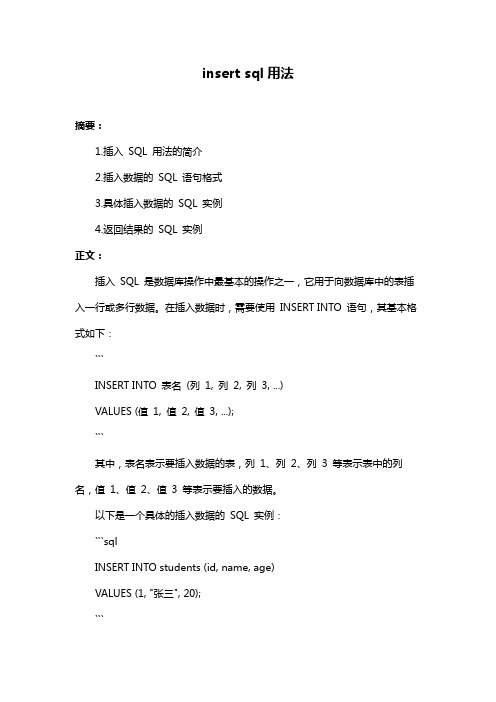
insert sql用法摘要:1.插入SQL 用法的简介2.插入数据的SQL 语句格式3.具体插入数据的SQL 实例4.返回结果的SQL 实例正文:插入SQL 是数据库操作中最基本的操作之一,它用于向数据库中的表插入一行或多行数据。
在插入数据时,需要使用INSERT INTO 语句,其基本格式如下:```INSERT INTO 表名(列1, 列2, 列3, ...)VALUES (值1, 值2, 值3, ...);```其中,表名表示要插入数据的表,列1、列2、列3 等表示表中的列名,值1、值2、值3 等表示要插入的数据。
以下是一个具体的插入数据的SQL 实例:```sqlINSERT INTO students (id, name, age)VALUES (1, "张三", 20);```这条语句向名为"students"的表中插入一行数据,这行数据的id 为1,name 为"张三",age 为20。
在插入数据时,如果插入的列名和要插入的数据的个数不匹配,或者插入的数据类型与表中列的数据类型不匹配,都会导致插入操作失败。
因此,在插入数据前,需要仔细检查插入的列名和数据类型。
除了插入数据,还可以使用INSERT INTO 语句返回插入操作的结果。
例如,以下语句向"students"表中插入一行数据,并返回插入操作的结果:```sqlINSERT INTO students (id, name, age)VALUES (1, "张三", 20)RETURNING *;```这条语句向"students"表中插入一行数据,然后返回插入的这行数据。
在插入操作成功后,可以得到一个结果集,结果集中的每一行数据都表示插入的这行数据。
